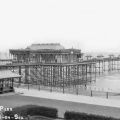The success of Hastings Pier in the 1870s and ‘80s prompted the construction of a rival promenade and entertainments centre in St Leonards.
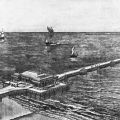 |
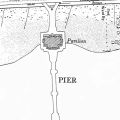 |
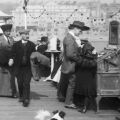 |
|
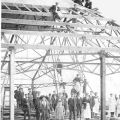 |
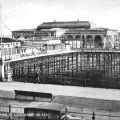 |
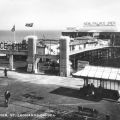 |
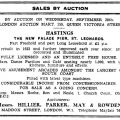 |
The first attempt to build a St Leonards Pier came in mid-1872, just before Hastings Pier opened. The St Leonards-on-Sea Pier Company had been set up in 1870 and had acquired the necessary legal powers to construct a 600-feet long pier roughly 100 yards east of the Royal Victoria Hotel. It would have been built by a Middlesbrough-based iron company and would have cost about £15,000.
But the pier company needed the consent of the St Leonards Commissioners who owned the esplanade, part of which the pier would enclose. When company directors appeared before the Commissioners in late July 1872, less than three weeks before their legal right to build a pier expired, their request was refused. They were told that this was because the out-of-town pier company had little local support and was not fully financed. The Commissioner who proposed the refusal, the Rev JW Tottenham, was also a shareholder in the Hastings Pier Company.
Over the following years it became clear that the town of Hastings was benefiting from its pier, so in 1885 new moves were made to build one in the rapidly expanding St Leonards. Parliament, under the 1861 General Pier and Harbour Act, gave the legal go-ahead that year for a pier to be built about 100 yards west of the hotel. Promoting the scheme were two local businessmen, Richard Reed and William Carless. Reed was to be the main driving force behind the new pier. He was the public-spirited owner of the Royal Victoria Hotel who thought (mistakenly) that there would be much local interest in such a pier and that it would be well supported.
In September 1886 a new St Leonards-on-Sea Pier Company was formed, and in early 1887 it began drawing up the plans and trying to find finance. Reed was the company chairman and Car less, a solicitor based in Warrior Square, was a fellow director. The St Leonards Pier was to be constructed in a similar manner to Hastings Pier, with an iron structure of columns connected by girders.
Work was started formally on Thursday 1 March 1888 by the mayoress, Mrs William Stubbs, with the first iron pile being screwed through the sand and clay. Practical building work began a month later. On 9 October 1890 she inserted the last of 22,500 bolts holding the substructure framework together.
The engineer and architect of the 960 feet long pier was local resident Mr R St George Moore, who was also the engineer of the Brighton Palace Pier, built 1891-99. The contractors were Messrs Head Wrightson and Co, of Stockton on Tees. It was to be constructed at a cost of £30,000, using 1,500 tons of iron brought in by sea.
But right from the beginning Mr Reed and the other company directors had great trouble raising funds for the project. Reed told the March 1889 AGM of the company that "when they [the directors] got near to the finish of the pavilion platform they found themselves placed in financial difficulty. They were obliged to have recourse to outside assistance." This came in the form of a cheap-rate £7,000 loan from the South Eastern Railway Company, which had recently opened its new station, West St Leonards, and was hoping that the new St Leonards Pier attraction would bring more train-using visitors to the town.
Reed said the problem was "due to the apathy of the owners of property in the neighbourhood". These people had expressed interest when the company was formed, but this did not take the shape of investment when the work started. The company "had not received a shilling of support from landowners, who would be considerably benefited by such an attraction, and which must be conducive to the welfare of the town." [Hastings News, 29 March 1889]
These financial problems delayed the building of the pier, and it was not completed until three and a half years after the work had started. Lady Brassey carried out the opening ceremony on 28 October 1891. The pier was hailed as a masterpiece of design and construction, with its main feature being the 750-seat semi-Moorish pavilion, designed by local architect Frank Humphreys, offering a variety of entertainment. But unlike Hastings Pier, which had its multi-purpose pavilion at the seaward end, making access difficult in bad weather, the St Leonards Pier pavilion was located close to the shore, and the horse-drawn carriages of the well-off could drive right up to the main door. The rest of the pier was for promenading, while at the end there was a large area for a future building. There was also a landing stage at the seaward end, but there was only occasional steamer traffic. The stage had to be rebuilt after it was washed away in a gale in October 1896, with its timber damaging the ironwork of Hastings Pier.
The pier was run and effectively owned by Richard Reed for several years until he sold the Royal Victoria Hotel and disappeared from the St Leonards scene. Some years later, when the hotel re-opened in March 1904 after being almost rebuilt, the local press commented on Reed, saying he was then personally bankrupt and "spending the evening of his life in the Strand Poor House" in central London. He had spent a fortune on the pier, and "got nothing in return". The pier, "which poor old Reed thought everybody wanted, and nobody did want", had been built 20 years too soon, said the Hastings Mail. Reed had been a "prominent Freemason" and the many other members in the town were called on to help him. [Hastings Mail, 12 March 1904]
The first moving pictures to be shown in Hastings and St Leonards were seen on St Leonards Pier on 7 November 1896. The pier’s west toll house was destroyed by a severe gale in February 1899. In 1904 the pavilion was turned into a fashionable lounge called the Kursaal.
On 1 April 1909 the ‘American Syndicate’, also known as the Rinkeries, took possession of the pier and carried out big improvements. The whole pier was painted and decorated and six ornamental kiosks erected, each accommodating three shops. It reopened on 23 May as the ‘American Palace Pier’ (often called just the Palace Pier). In July that year a new pavilion was built as a roller skating rink at the seaward end of the pier. It had a steel frame, with the top half of its walls being glass that could be pulled up all around to admit the air. Its flooring was maple.
In August 1917 a Mr John Henry Gardner moved to St Leonards and took over the pier. He became well known for his generous support for local charities and his attempts to make the pier a success.
But although the St Leonards Pier was an important attraction, it was an ongoing financial failure. Gardner effectively went bust in 1927 and offered the pier to Hastings Council for a mere £9,000. But the Council refused because of the high cost of reconditioning the structure, estimated at £21,000. Supporters of the pier disputed this cost, pointing out that over the previous two years the pavilion had been reroofed and repainted inside, a large sum had been spent on the substructure and the skating rink had been repainted.
Gardner, heavily in debt, continued running the pier until July 1933, when the denture holders gave up and sold their shares to London brothers David and Philip Lannon. They appointed a man named Arthur Collins as the 'lessee', on behalf of a company called Southern Piers Ltd. He renamed the pier as the New Palace Pier in March 1934 and promised it would be reconstructed and brought up-to-date.
Then on 7 July 1934 the lively national magazine John Bull exposed all the Lannon purchase as an "Astounding Seaside Pier Scandal". It revealed that all these "notorious people" were shady characters with dubious pasts. Mr Collins, whose real name was Arthur Cohen, was the sole owner and director of Southern Piers, which had only been formed in December 1933, with just £1,000 capital. The Lannons, along with another man and their brother-in-law Cohen, had been involved in setting up a £250,000 business for the purchase of an American talking machine. This deal collapsed, but the Lannon group walked away with large sums of money. They also set up many highly criticised money-lending schemes, one of which had bought the pier.
John Bull concluded: "To give a full list of the ventures which the Lannon Brothers have been associated with would be impossible. Time and again their tangled affairs have been thrashed out in the bankruptcy courts, and hard things have been said of their conduct by officials. ... In these circumstances we shall watch the developments of Southern Piers Ltd and the New Palace Pier with interest."
Despite the scepticism of the John Bull, extensive changes and improvements were made, reflecting the changing trends in holiday making. Numerous well-known dance bands were engaged, and the new attractions ranged from a bridge congress to all-in wrestling. But the Lannons had soon had enough, and in September 1938 their solicitor placed an advertisement in the Hastings Observer saying that the pier was up for auction in London. But it failed to reach its reserve price, with the the highest bid being £34,750.
The advertisement said the New Palace Pier had been “virtually rebuilt in 1933 and further improved each year since”. It had “modern bars, dance pavilion and café seating nearly 1,000, with up-to-date kitchens, furniture and effects” and “extensive amusement arcades amongst the largest on the south coast”.
St Leonards Pier came to the end of its life as a public amenity on the outbreak of the Second World War. It was closed and requisitioned by the military, and in 1940 a section of it was removed as a defence measure, as happened with Hastings Pier. In October that year it suffered damage from a bomb attack, leaving it semi-derelict, and it was hit by severe gales in early February 1943.
Then on the evening of Tuesday 7 March 1944 a major fire seriously damaged all the shore end of the pier, wrecking the pavilion and adjoining buildings. The Pier was never to recover from this "spectacular blaze", as the Hastings Observer described it. "The fire raged for with extreme ferocity for about an hour, and the flames and smoke could be seen for miles along the coast. The fire started at about 5.40pm and in a few minutes great sheets of flame were crackling skywards and a huge pillar of smoke rolled out to sea. ... The next day an Observer reporter was allowed access to the pier. The once gay and ornamental pavilion and amusement arcade presented a pathetic picture of charred and twisted ironwork. ... Although the St Leonards Pier, which had suffered considerably from the effects of the war, had latterly been in a semi-derelict condition, many people will regret the fate which overtook it, for through half a century it had provided entertainment for people of all ages and tastes, and played a part in the social and cultural life of the town which deserves full recognition." [Hastings Observer, 11 March 1944]
The St Leonards Pier owners exhibited little interest in the fate of the pier after the war ended, making no attempt to restore it. It was never reopened to the public, and in late December 1950 Hastings Council decided to purchase it for demolition.
Work began in early February 1951. But the superstructure and remaining piles and girders were further damaged in a severe gale on 13 March that year, with the seaward end collapsing into the waves. Demolition took longer than expected, and the Royal Engineers of the Territorial Army carried out the final stages of removing the piles in the summer of 1953.
There is no surviving remnant of St Leonards Pier. There is an information board near where it stood, plus a small, almost illegible sign on the promenade railings commemorating the 1896 film show.
